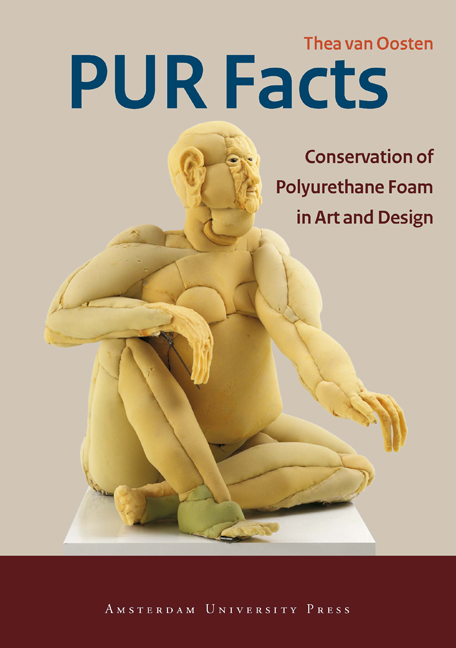Book contents
- Frontmatter
- Contents
- Preface
- Introduction
- 1 Polyurethanes, Manufacture and Applications
- 2 Chemistry, Properties and Degradation
- 3 History of Polyurethane foam Conservation
- 4 Ageing Behaviour of Polyurethane foam
- 5 Assessing the Condition of Polyurethane foam
- 6 Case Studies
- Acknowledgements
- Glossary
- General Information
- Bibliography
1 - Polyurethanes, Manufacture and Applications
Published online by Cambridge University Press: 14 January 2021
- Frontmatter
- Contents
- Preface
- Introduction
- 1 Polyurethanes, Manufacture and Applications
- 2 Chemistry, Properties and Degradation
- 3 History of Polyurethane foam Conservation
- 4 Ageing Behaviour of Polyurethane foam
- 5 Assessing the Condition of Polyurethane foam
- 6 Case Studies
- Acknowledgements
- Glossary
- General Information
- Bibliography
Summary
What are polyurethanes?
Polyurethanes (PUR) are a family of plastics with different compositions and numerous applications, including cellular materials (flexible and rigid foams), fibres, soft and hard rubber (elastomers), surface coatings and adhesives. Polyurethanes are formed by the reaction of a diol (alcohol with two reactive hydroxyl groups) or a polyol (an alcohol with more than two reactive hydroxyl groups per molecule) with a diisocyanate (cyanate with two reactive sides) or a polyfunctional isocyanate (with more than two reactive sides) in the presence of suitable catalysts and additives (Bruins 1969).
Polyurethanes can be found as thermoplasts, thermosets and rubber (elastomeric) materials.
Thermoplastic polyurethanes consist of linear, long-chained polymers (Figure 1), and they are formed when difunctional reactants (a diol and a diisocyanate) are used.
Thermosetting polyurethanes are branched or cross-linked polyurethanes which are formed if three or more functional reactants (a triol and polyfunctional isocyanate) (Figure 2) are used.
Rubber (elastomeric) polyurethanes are co-polymers of hard polyurethane and very flexible polyurethane in which microphase segregation of the hard phase occurs (Figure 3).
The clusters of hard polyurethanes shown as thicker lines act as ‘pseudo cross-links’ and allow the material to behave as a rubber (Figure 4).
These thermoplastic-thermosetting polyurethanes come about when an excess of the diisocyanate component is charged during polymerisation. This excess allows the formation of cross-links subsequent to the formation of linear polymer chains and during the post-cure of the formed article. When the temperature is raised, the clusters disassociate, and the material can be made to flow; when subsequently cooled, the clusters reform, and the material again exhibits elastomeric properties. These materials exhibit elastomeric behaviour at room temperature, but can be processed as thermoplastics. Hence the name of this class of materials: thermoplastic urethane elastomer. When hard clusters predominate, thermosetting polyurethanes are formed, whereas soft clusters will give thermoplastic polyurethanes (Dombrow 1957) (see Figure 1-4).
Polyester is a family of organic polymers characterised by the presence of ester groups RO-C=O within the molecule. Polyesters can be prepared so that they have reactive hydroxyl groups and can thus be used as a polyol in the preparation of polyurethane ester foam.
- Type
- Chapter
- Information
- PUR FactsConservation of Polyurethane Foam in Art and Design, pp. 13 - 28Publisher: Amsterdam University PressPrint publication year: 2011



